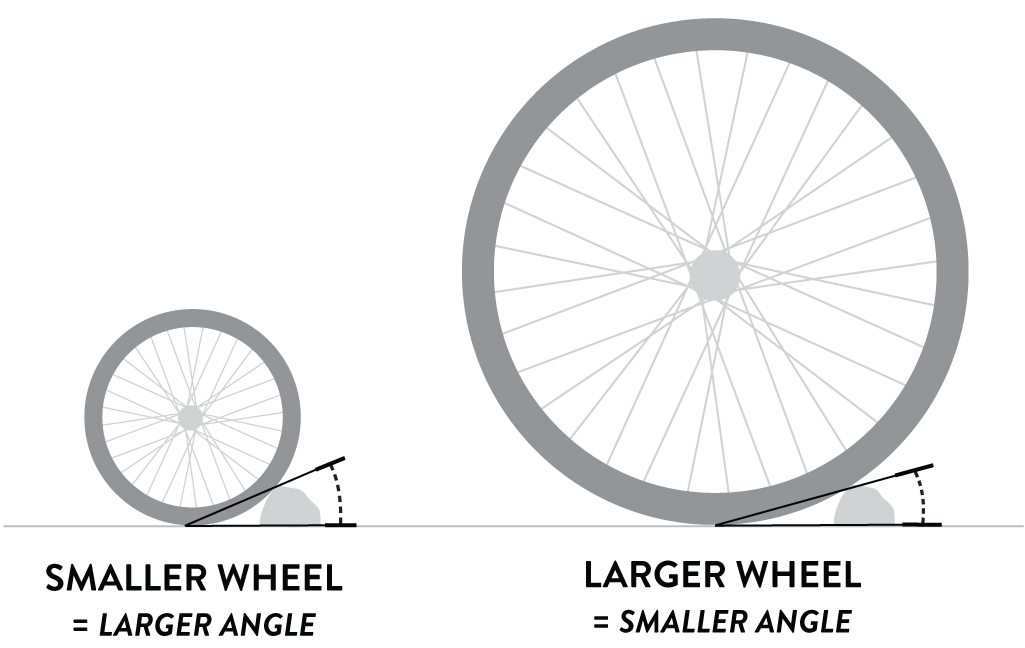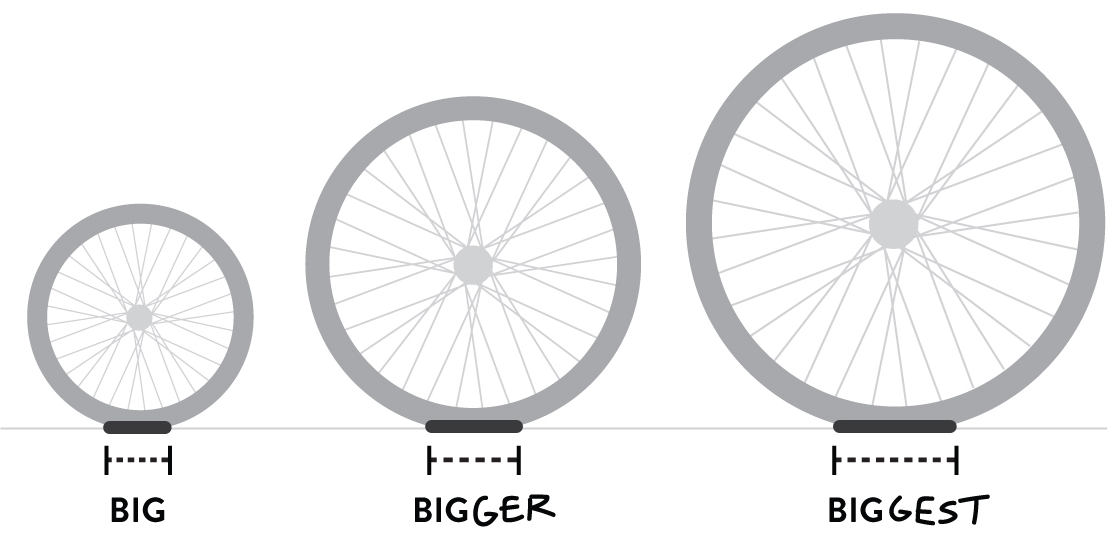How to Choose a Mountain Bike Wheel Size
We’d all like to think that size doesn’t matter, but when it comes to mountain bike wheels, that’s just not the case. Mountain bike wheels are most commonly referred to by their diameter in inches. While the original standard for mountain bikes was 26” wheels, several new standards have emerged over the past few years. First, the 29” mountain bike wheel (commonly called "29ers") and more recently the “Goldilocks” middle standard wheel size of 27.5”. Numbers are good and all, but what does that mean? Read along and we'll help you choose if a 29er vs. 27.5" wheeled mountain bike is the right choice, or if the latest mixed wheel (aka mullet bike) trend makes the most sense for you.
29” bike wheels are actually the same diameter at the rim as the 700c standard you may recognize from road bikes, while the 27.5" (also called 650b) standard comes from European touring and tandem bikes. Regardless of where these wheel sizes originated, there are advantages and disadvantages to going to a larger or smaller wheel size.
Advantages of Larger Mountain Bike Wheels
Angle of Attack

This is one of the key arguments for going to a larger mountain bike wheel size. Not all trails are smooth and buff and larger wheels have an advantage here. Angle of attack refers to how high up on the wheel a particular object hits when a bike wheel is rolling over it relative to other sizes. Imagine trying to roll over a stick or small rock with tiny skateboard wheel vs a tractor tire. The skateboard wheel won’t even come close to rolling over it and will get hung up whereas the tractor won’t even notice that it’s there. This is because of the angle at which the object comes into contact with the wheel. All other things held constant, larger mountain bike wheels will roll over obstacles and maintain speed on rough terrain better than a smaller wheel.
Contact Patch Size

With a larger mountain bike wheel, you also get a larger contact patch size. This simply means that once the tire conforms to the ground, there’s a bigger patch of knobby rubber making contact. Anything that is aided by more traction like braking, technical climbing, or cornering, is easier with a larger contact patch.
Please note: This does not mean that bigger wheels are better at technical climbing or cornering, it simply means that you’ll get more traction relative to a smaller wheel in those situations.
Advantages of Smaller Mountain Bike Wheels
Acceleration
Smaller mountain bike wheels, all other factors held constant, will pick up speed faster than a larger wheel. Tight and twisty trails requiring you to pedal out of corners will favor a smaller wheel that picks up speed faster.
Stronger Wheel
A wheel is only as strong as the tension of its spokes. The longer the spokes, the less tension and strength. Longer spokes means there’s a longer lever-arm to wrench on them when you case that jump or drop a little catty-wumpus. What you may feel with a larger wheel is more flex but unless you’re a DH racer, dirt jumper or Josh-Bender-esque free-hucker, wheel strength is an increasingly mitigated issue because rim, spoke and hub designs have improved vastly in the past 10 years. The recent Boost 148 development is a great example of improved large wheel stiffness.
Better Cornering Mechanics
There’s a lot that goes into what many consider the most technical mechanic in mountain biking. It is generally accepted that smaller mountain bike wheels work towards better cornering in several ways. Being lower to the ground, smaller wheels will take less movement of the arms to produce a lean angle required for cornering. Since smaller wheels are also generally lighter, there’ll be less gyroscopic effect of the wheel righting the bike and fighting against your efforts to lean the wheel. Although larger diameter wheels may hold more traction and speed through a corner, the decrease in agility and lean angle may be seen as a drawback on a twisty trail.
Mixed Wheels (aka Mullet Bikes)
Mixed wheel mountain bikes, also known as MX or mullet bikes, have seen a surge in popularity in recent years, particularly in the enduro and downhill mountain biking scenes. This configuration utilizes a 29-inch wheel in the front and a 27.5-inch wheel in the rear — alas the business in the front, party in the back namesake. This combination aims to provide riders with the best of both worlds.
Business in the front: The larger 29-inch front wheel improves handling over rough terrain, maintains momentum at speed, and rolls over obstacles with ease.
Party in the back: The smaller 27.5-inch rear wheel enhances the bike's agility and responsiveness, making it easier to maneuver tight corners, tweak out in the air and navigate technical sections of trail.
In conclusion, mixed wheel setups cater to riders who seek a balance between the stability of a 29er and the agility of a 27.5 bike. If you find yourself drawn to both worlds, a mullet setup might be the perfect choice for your next mountain bike.
Other Considerations
Wheels are a major component to any bike and the size of the wheel affects a lot of other things that you might not think of.
In particular, frames need to be engineered around the wheels. In general, bikes with larger wheels will have longer chainstays, wheelbases and taller stack heights than smaller wheeled bikes. Not many bicycle manufacturers produce a size S or XS 29’er for that reason. If you’re 5’7” or smaller, 29’ers are likely to feel too big. Conversely, if you’re a big, tall guy and always feel like a bear riding a unicycle on 26” wheels, bigger 27.5” or 29” wheels may feel more natural.
Additionally, suspension components also need to accommodate larger wheels. Fork lowers need to be longer and taller in order to fit larger wheels and as a result, 29’ers tend to have less suspension travel than their 27.5” and 26” counterparts (although the advent of Boost 148 also mitigates this to an extent). Since the wheel size difference is less, 27.5” wheels aren’t usually penalized by their suspension travel like 29’ers. Full travel 27.5” downhill bikes have recently made their appearance.
Decisions, decisions...
So who wins the 29er vs. 27.5 debate? That comes down to your preference as a rider. In general, bigger mountain bike wheels (29ers in particular) are better uphill and in a straight line over rough terrain. The smaller wheels tend to be more nimble and have more suspension travel. One isn’t necessarily better than the other and a lot of rider preference and terrain choice is going to come into play.
Like most bike related discussions, sometimes the best way to tell the difference is to throw a leg over and get a feel for each!
Learn More With Our Other Bike Guides:
- Mountain Bikes - How to Choose
- Mountain Bikes - Size and Fit Guide
- Mountain Bikes - How to Get Started Mountain Biking
- Mountain Bikes - How to Choose a Wheel Size
- Mountain Bikes - Suspension Basics
- Mountain Bikes - How to Choose a Mountian Bike Dropper Post
- Mountain Bikes - How to Choose MTB Handlebars
- Mountain Bikes - How to Choose MTB Pedals
- Mountain Bikes - How to Change Bike Pedals
- Mountain Bikes - How to Clean
- Mountain Bikes - How to Bleed SRAM Brakes
- Mountain Bikes - How to Bleed Shimano Brakes
- Mountain Bikes - How to Convert to Tubeless Tires
- Mountain Bikes - How to Replace Internal Cable Housing
- Mountain Bikes - How to Adjust Your Rear Derailleur
- Mountain Bikes - How to Bleed a RockShox Reverb Seatpost
- Mountain Bikes - How to Service Fox and RockShox Fork Lowers
- Mountain Biking - What to Bring Mountain Biking
- Mountain Biking - What to Wear Mountain Biking
- Mountain Biking - How to Choose Knee Pads
- Bikes - Size and Fit Guide
- Gravel Bikes - How To Get Started Gravel Biking
- eBikes - Classes, Features & More
- eBikes - Where to Ride eBikes
- Bike Accessories - Helmet Size & Fit Guide
- Bike Accessories - How to Choose Bike Shoes
- Bikes - How to Choose Bike Tires
- Bikes - How to Change Bike Pedals
- Bikes - How to Repair & Replace a Bike Chain
- Bikes - How to Choose Accessories
- Bikes - Urban Riding Tips
- Travel & Destination Guides - Where to Mountain Bike
Learn About our Favorite Bike Gear:
The Best Women's Mountain Bikes
The Best Electric Mountain Bikes
The Best Mountain Bikes for Beginners
The Best Mountain Bikes Under $3,000
The Best Trail Bikes
The Best Enduro Bikes
The Best Gravel Bikes
The Best Mountain Bike Helmets
The Best Full Face MTB Helmets
The Best Mountain Bike Knee Pads
The Best Mountain Bike Elbow Pads
The Best Mountain Bike Shorts
The Best Women's Bike Shorts
The Best Mountain Bike Pants
The Best Mountain Bike Jerseys
The Best Mountain Bike Accessories
The Best Value Mountain Bike Helmets
The Best Dropper Posts
The Best Mountain Bike Forks
The Best Mountain Bike Stems
The Best Padded Mountain Bike Shorts
The Best Mountain Bikes Handlebars
The Best Gifts for Mountain Bikers
The Best Mountain Bike Gloves
The Best Mountain Bike Socks
The Best MTB Fanny Packs
The Best Mountain Bike Backpacks
The Best Clipless Mountain Bike Shoes
The Best Flat Pedal MTB Bike Shoes
The Best Mountain Bike Tires
The Best Mountain Bike Flat Pedals
The Best Bike Racks
The Best Bike Glasses
The Best Bike Goggles
The Best Women's Mountain Bike Jerseys
The Best Tailgate Bike Pads
The Best Bike Trainers
The Best Hitch Bike Racks
The Best Clipless MTB Pedals
The Best Mountain Bikes Handlebar Bags
The Best Mountain Bike Saddles
The Best MTB Wheels
The Best MTB Grips
The Best Mountain Bike Multi Tools
The Best Mountain Bike Seat Bags
Popular Bike Searches
This is evo. We are a ski, snowboard, wake, skate, bike, surf, camp, and clothing online retailer with physical stores in Seattle, Portland, Denver, Salt Lake City, Whistler, and Snoqualmie Pass. Our goal is to provide you with great information to make both your purchase and upkeep easy.
evo also likes to travel to remote places across the globe in search of world-class powder turns, epic waves, or legendary mountain biking locations through evoTrip Adventure Travel Trips. Or, if you prefer to travel on your own, check out our ski & snowboard resort travel guides and mountain bike trail guides.
Still have questions? Please call our customer care team at 1.866.386.1590 during Customer Care Hours. They can help you find the right setup to fit your needs.